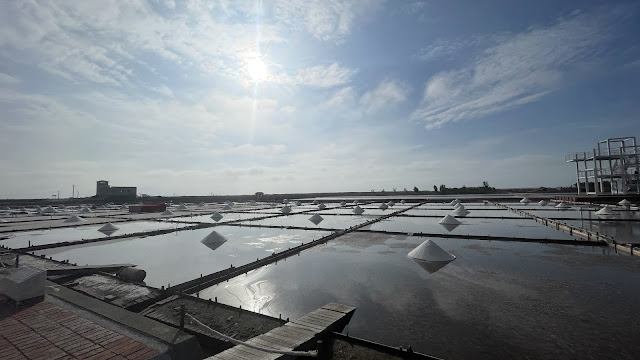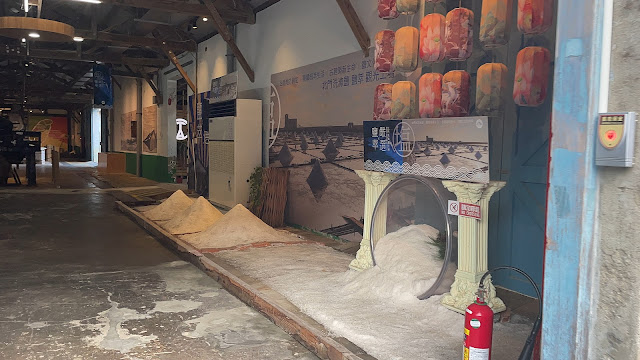Travel Date: 2024/10/26
On October 16, Tainan’s Beimen Visitor Center launched the Glory Taiwan: Sustainable Tourism Connecting the World exhibition as part of Taiwan’s Tourism Bureau’s anniversary celebrations. The 2024 Kunshen Wang Peace Salt Festival will was held on October 26-27, featuring events like the Pah-Peng Challenge with cash prizes, a Peace Salt Bag exchange, and a concert.
The Yunlin-Chiayi-Tainan (Yunchianan) Coastal Scenic Area Management Office has also organized the Beimen Temple Culture Tour in collaboration with local schools. This tour includes visits to temples where participants can collect stamps, redeemable for a limited-edition golden postcard on October 26.
Beimen District (北門)
Located in northwest Tainan, Beimen District, once a sandbar at the Jishui River mouth, has rich mangroves, a tropical climate, and an economy based on agriculture and aquaculture.
During the Daoguang period, salt production expanded in Beimen, experiencing a revival in 1899 after the Japanese colonial government reinstated salt monopolies. Beimen was once part of Tainan County but became Beimen District in 2010 after administrative restructuring that incorporated Tainan County into Tainan City.
Historically, Beimen’s population peaked in 1966 with 19,502 residents. Since the 1960s, industrial changes and the high labor demands of salt harvesting led many young adults to seek employment elsewhere, particularly in northern cities like Taipei and Kaohsiung. Recently, as employment opportunities have grown locally due to nearby science parks, the trend of outward migration has decreased. By 2023, Beimen had approximately 10,000 residents, facing similar aging and low birth rates to other areas in Taiwan.
Xing’an Temple (興安宮)
Around 200 years ago, ancestors of today’s residents migrated from Oulei Village to Yonghua Village, where they established Yingling Temple to honor Ji Fu Qiansui, seeking his blessings for protection, favorable weather, and peace. Over time, a unique spiritual exchange took place: Ji Fu Qiansui from Yingling Temple and Chi Fu Qiansui from Bao’an Temple were ceremonially “swapped” based on divine guidance, resulting in Ji Fu Qiansui’s permanent enshrinement in Oulei Village.
By 1976, the temple had fallen into disrepair, prompting the community to establish a reconstruction committee. With blessings from significant temples like Nankunshen and Bao’an, and support from dedicated patrons, rebuilding began. The newly completed temple opened in 1980, officially named Xing’an Temple in 1981, preserving the village’s rich cultural and spiritual heritage.
Jingzijiao Wapan Salt Fields (井仔腳瓦盤鹽田)
The Jingzijiao Wapan Salt Fields, Taiwan's oldest traditional salt production site with over 200 years of history, are celebrated for their scenic views and popularity among photographers, especially at sunset. Open year-round with free entry, visitors can observe salt production, often seeing workers tending to the fields in the early hours.
Salt-making along Taiwan's coast began centuries ago, initially by boiling seawater or trading with mainland China. In 1648, the Dutch East India Company attempted salt mining, but poor results led Taiwan to rely on imports until only small-scale production remained after the Dutch era. Under Japanese rule in 1895, the industry transformed as the Taiwan Salt Co., Ltd. was founded in 1919 to meet growing salt demands.
Relocated to northern Tainan in 1818, these fields became known as Yongdong Field. In 1952, they were redesigned with “tiled-paved” ponds lined with pottery and tile shards, producing clearer salt and speeding evaporation.
Today, the Yunjianan National Scenic Area has revived Jingzijiao as a cultural site. Visitors can enjoy a viewing tower, local salt products, and an enchanting, mirror-like view at dusk, where salt mounds reflect the sky. Designated play areas let children enjoy salt like snow, making Jingzijiao a magical experience for all.
Beimen Visitor Center (北門遊客中心)
Housed in the historic warehouses of the former Beimen Salt Washing Factory, the Beimen Visitor Center has become a lively attraction. With its theme, "Beimen Wedding Photography Paradise," the center features colorful artworks by local artist Hong Tong and vibrant murals ideal for wedding photos, drawing many visitors.
Inside, guests are welcomed by interactive floor projections that mimic Beimen’s coastal ecosystem, complete with playful bird footprints. A striking centerpiece is the preserved skeleton of a sperm whale, returned after international exhibitions, alongside a floor map of the Southwest Coast National Scenic Area that showcases key attractions.
The center also offers interactive multimedia games, making it a hit with children and an ideal first stop for discovering Beimen’s charm.
Beimen Salt Refinery (北門洗滌鹽廠)
The Beimen Salt Refinery in Tainan City, Taiwan, is a historic salt processing plant owned by the Taiwan Salt Industrial Corporation. Built in 1936 by the Monopoly Bureau of the Taiwan Governor’s Office during Japanese rule, the refinery aimed to produce 18,000 metric tons of salt annually. Its production reached impressive levels, with 17,096 and 18,386 metric tons in 1940 and 1941, respectively, establishing it as a key salt supplier for Taiwan.
After World War II, the Taiwan Provincial Administrative Office took over the refinery in 1946. Following extensive repairs, the plant resumed full-scale operations in 1955. In 1964, it began producing iodized salt with support from the United Nations, fulfilling Taiwan’s growing demand for iodine-enriched salt. A major facility upgrade in 1978 boosted its annual output to 30,000 metric tons. However, due to shifts in industry demand, the refinery ceased operations in 1998.
In 2003, Tainan County Government designated the refinery as a historical site, preserving this unique wooden structure—the only remaining Japanese-era salt refinery of the original four constructed by the Monopoly Bureau. The Beimen Salt Refinery, now a cultural landmark, offers visitors a window into Taiwan’s rich salt production history and its role in introducing iodized salt to the region.



























0 komentarze:
Post a Comment